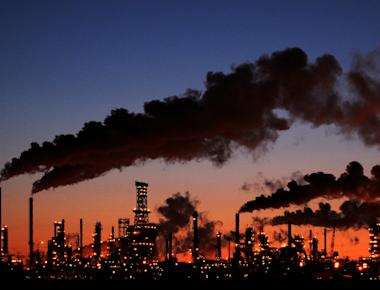

What exactly is urbanization? In simple terms, urbanization can be defined as the growth of cities in a region. Such a process usually happens through a “population shift from rural to urban areas, the corresponding decrease in the proportion of people living in rural areas, and the ways in which societies adapt to this change.” For over fifty years, urbanization has fueled a “spreading wildfire” in West Africa, and it isn’t showing signs of stopping anytime soon.

United States Geological Survey
Firstly, West Africa is known to be blessed with unique beauty and biodiversity. Unfortunately, forests are being cut down to make space for urbanization, which is causing the natural beauty to be quickly diminished. Specifically, increased demand for food from the rising urban population requires converting forests into agricultural fields. In the map of West African countries above, the green and dark green areas represent fragmented forests. To put this into perspective, over 90% of West Africa’s coastal rainforest has already been destroyed. The impacts of deforestation from urbanization are massive. Most importantly, people are affected as Africa’s forests support 100 million people by reducing air pollution; thus, it is no surprise when deaths from outdoor pollution have risen by 36%. In West Africa, this percentage amounts to nearly 1 million deaths each year.
Alongside deforestation comes the effects of factories. Urbanization in an area typically begins when a factory is established, and many of these factories have extremely poor waste management. For instance, in Nigeria, more than 250,000 tons of waste are generated per year as a direct result of urbanization. As a whole, about 90 percent of industries in West Africa discharge their wastes into the environment. Consequently, pollution has and will continue to increase in West Africa.

CDC Museum
Another problem worth considering is that West Africa’s rising population leads to a reduction in the quality of health through the spread of diseases. The first factor of increasing diseases is that urbanization increases poverty. Because there is “a greater demand for housing than the urbanized area can supply”, slums are created and are prone to hazards such as flooding and water shortages. Essentially, contracting disease is more likely as highly infectious diseases are precipitated by a high population, which we see in West Africa. Furthermore, disease transmission is exacerbated through deforestation, a problem that was already established earlier. Deforestation equals more exposure between people and wildlife. In fact, 6 out of 10 infectious diseases in humans are transmitted from animals. As you can see in the diagram, outbreaks have already occurred as deadly diseases moved into countries such as Guinea. Thus, not only does urbanization increase the proliferation of diseases, but it also makes it harder to contain during, say, a pandemic because it reduces contact tracing. The CDC concurs that yellow fever causes 30,000 deaths each and every year in West Africa.
Finally, it is of utmost importance to note that development in Africa is followed by corruption and has led to a public crisis. This happens through the informal sector, as rapid population growth forces over 90% of people to work in the informal sector, essentially illegal and unsustainable jobs with less pay. The jobs in this sector force people to work in unsafe and unhealthy conditions. Furthermore, intense urbanization of regions leads to weak governance. In West Africa, such corruption is caused by the government’s scant understanding of bribery, with several officials in urban Nigeria accepting bribes. With limited employment for young low-skilled migrants in cities and towns, and low levels of governance, urbanization can expose a variety of people to the drug market. This is precisely what is occurring when one thousand kilograms of cocaine are flown into Guinea every night.
In essence, while West African urbanization may seem to bring numerous benefits from the outside, a closer examination can reveal a plethora of harms. During urbanization, the environment is destroyed, leaving the biodiversity nearly depleted. Deforestation and an increase of slums can also link to increased disease transmission, which causes a public health crisis through drug and government corruption. In this scenario, the harms will heavily outweigh urbanization’s benefits.
Sources
Bourzac, K. (2019, April 23). Air pollution kills 780,000 people in Africa each year. C&EN. https://cen.acs.org/environment/pollution/Air-pollution-kills-780000-people/97/i17.
Centers for Disease Control and Prevention. (2018, September 14). Global Health - Newsroom - Yellow Fever. Centers for Disease Control and Prevention. https://www.cdc.gov/globalhealth/newsroom/topics/yellowfever/index.html.
Crossan, A. (2014, October 9). Here’s how cutting down West African trees made us vulnerable to Ebola. The World from PRX. https://www.pri.org/stories/2014-10-09/heres-how-cutting-down-west-african-trees-made-us-vulnerable-ebola.
How the interplay between large and small informal firms affects jobs in West Africa. World Bank Blogs. (n.d.). https://blogs.worldbank.org/jobs/how-interplay-between-large-and-small-informal-firms-affects-jobs-west-africa.
The increased cost of air pollution in Africa calls for urgent mitigation action, says new OECD Development Centre study. OECD. (2016, October 17). https://www.oecd.org/dev/africa/air-pollution-africa.htm.
Jordan R. Fisher, G. I. (2019, October 3). Urban Slums: How and Why They Form. ThoughtCo. https://www.thoughtco.com/massive-urban-slums-1435765.
Loewenstein, A. (n.d.). How South American drug cartels created a narco-state in West Africa. British GQ. https://www.gq-magazine.co.uk/culture/article/guinea-bissau-drug-cartels-antony-loewenstein.
Quartey, J. (n.d.). An Economic Assessment of the Deforestation of Ghana’s Garden City of West Africa. Link Springer. https://link.springer.com/chapter/10.1007/978-94-007-1969-9_30.
Subscribe to our newsletter!
Quick Links
Legal Stuff



